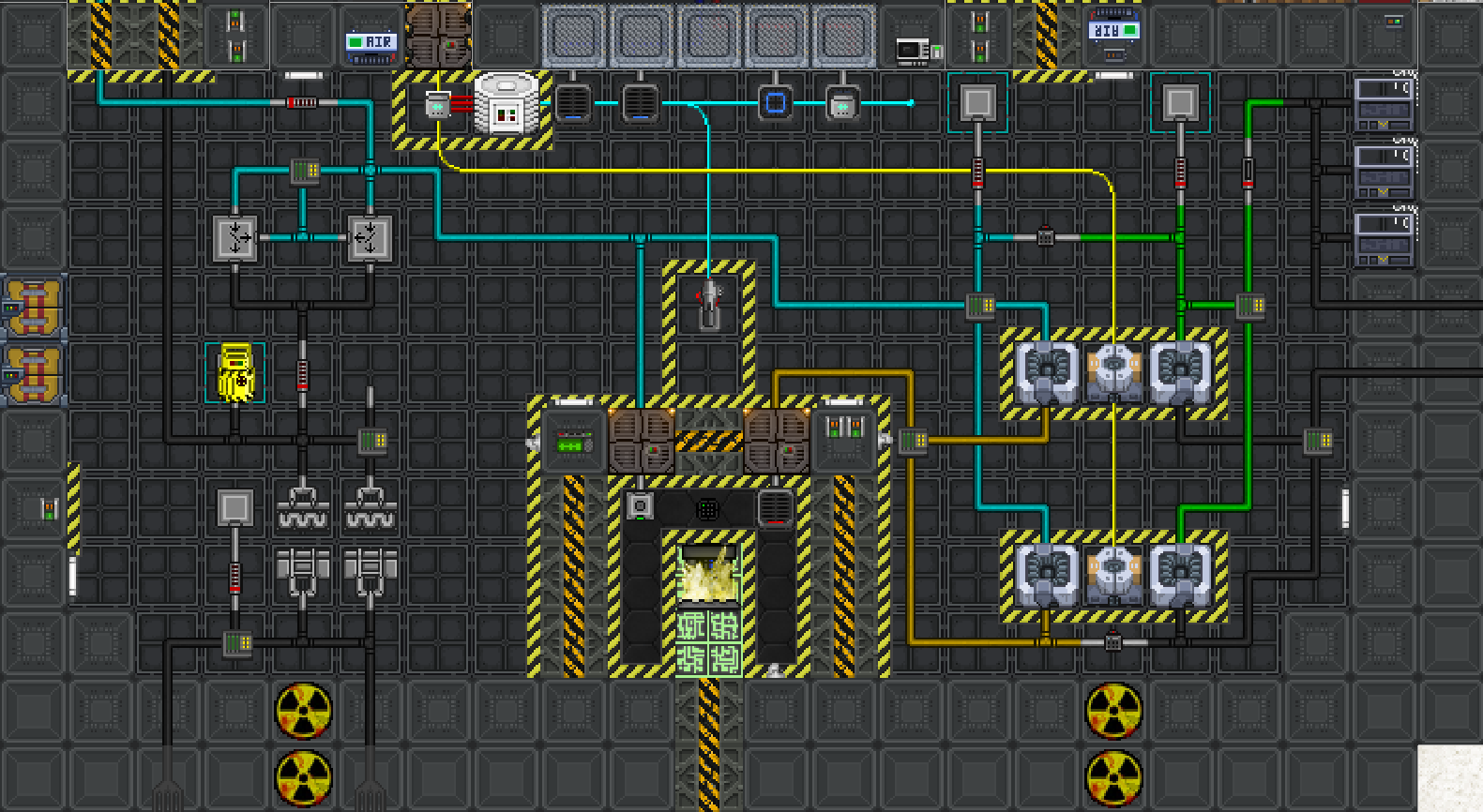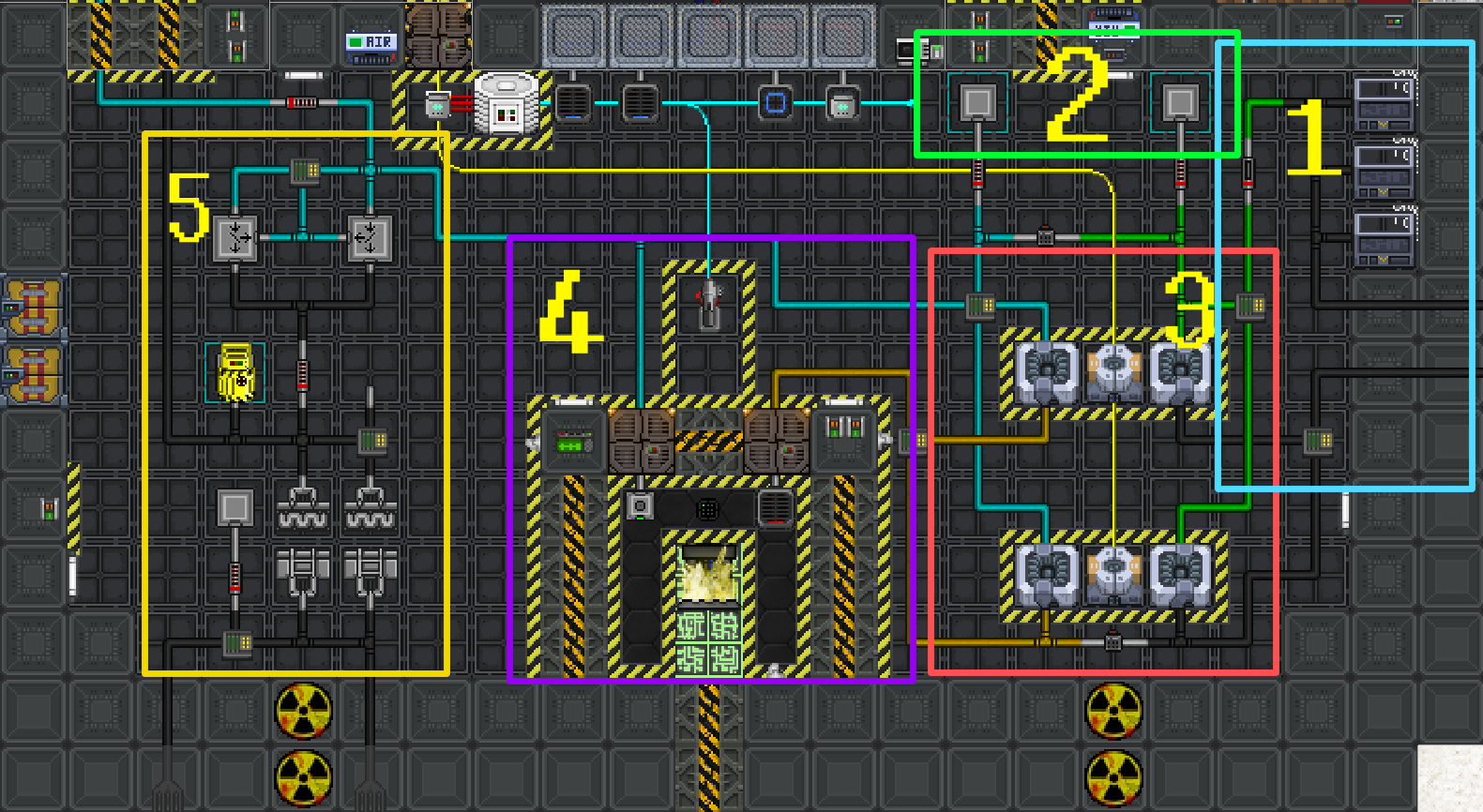Guide to the Supermatter
The supermatter engine, located in the south part of Engineering, is the main source of power for Cryogaia Outpost
.
The supermatter engine can be extremely dangerous; when deliberately tampered with or poorly set up, it can easily blow a substantial hole in Engineering and leave the facility all but powerless in the aftermath. You will also be mocked by the crew for your failures so if it seems unsafe don't do it, you'll save later engineers a lot of headache.
A lot of this guide wouldn't be possible without the help of Laria Darlos, Chief Engineer on Cryogaia outpost. Credit goes to her for most of the knowledge on this page, and also for the Waste Loop to Atmos filter design.
Already know how to set up the Supermatter by heart? Check out the Guide to Advanced Supermatter Hacking.
Safety First
There are a few important safety principles to remember when working with the engine:
- The supermatter is extremely dangerous. You can pull it, but any other attempt to touch or grab it, or bumping into it, or trying to use an item on it (you get the idea) will result in you instantly turning into a pile of ash.
- If it is absolutely essential to interact with the supermatter, you will want to ensure that you have received a backup implant from Medbay in case something goes wrong.
- The radiation from the supermatter is also dangerous. Inactive crystals release low levels of radiation, even at idle, the SM produces enough radiation to cause damage anywhere in the engine room. You should wear a radiation suit, with a hood, at all times when working in the active engine.
- Suits are available in the engine entrance airlock, the engine monitoring room, and the engine gas storage room.
- Engineering voidsuits will not protect you from radiation. They provide some protection, enough to keep you out of immediate danger if you need to work with the engine while it is not atmospherically stable, but you should always wear a radiation suit if possible.
- The Chief Engineer's voidsuit and EVA suit are fully rad-shielded, in the event that prolonged exposure to both the supermatter and vacuum are mandatory.
- The supermatter, even while inactive, will cause hallucinations and other mental effects if seen directly. Optical meson scanners
 must always be worn when working in the engine room.
must always be worn when working in the engine room.
- Meson scanners are available in the same lockers as the radiation suits, though you should probably be wearing your own pair from your locker anyway. They don't need to be turned on to protect your eyes, you just need to be wearing them.
- The laser from the emitter is incredibly deadly. Don't walk in front of the emitter while it is on.
- The emitter beam is capable of damaging and destroying the core blast doors if they are kept closed. Always ensure that the blast doors are open when firing the emitter.
A Tour of the Engine Room
If you are new to the engine and the only engineer on shift, skip ahead to "Engine Setup" for a quick guide on how to get the engine running, and come back to this later. If there are other experienced engineers online, ask them for help learning the engines.
Labelled Engine Room
Label meanings
1. The cold loop cooling segment. Hot air goes through the black pipes, from the bottom of area 3, up and out of the station and is cooled by the extreme cold of the planet's atmosphere. The cooled gas then goes back into the green pipes, to be re-used in the thermoelectric generators.
2. The two intake valves. Place canisters of gas here and wrench them in to hook them up to the pipeline. Don't forget to turn the pumps on, so the gas is actually extracted. The left line is for the hot loop, and the right is for the cold loop.
3. These are the actual thermoelectric generators. They generate power based on the temperature difference between two gas lines. Hot gas goes in the left side (the yellow pipes), cold air goes in the right (green pipes), and then exit out of the blue and black pipes, respectively. Air in the exit "waste" pipes need to be filtered and re-cooled under most circumstances.
4. This is the supermatter chamber. Gas goes in through the blue pipe, is heated by the supermatter, and is then pumped through the yellow pipes to the thermoelectric generators. The SM won't heat anything if it's not being hit by the Emitter in the center of the room though.
5. This is the supermatter "waste" line. When the SM interacts with gases, it will split those gases (or create them) and release them into the air around it. These gases, especially Oxygen are extremely bad for the crystal, and generate very little power. Using the two filters, it's possible to leave only phoron in the cooling loop, and exile all the rest of the gases to the waste canister(or atmos, if you have that setup).
Producing Power
The engine uses a Thermoelectric Generator - TEG for short. Its left side is heated by the supermatter, while the right side is cooled using the extreme cold outdoors. There are two TEGs, each has a nominal maximum output of 500 kW of electricity, though higher power outputs are entirely safe.
In its base state, the supermatter does not produce any heat, but when it is activated by the ![]() emitter which is in the engine room for this purpose, the core begins to heat up. For this reason, in order to produce heat and therefore power, the supermatter must be energized using the emitter; this is referred to as "starting" the engine.
emitter which is in the engine room for this purpose, the core begins to heat up. For this reason, in order to produce heat and therefore power, the supermatter must be energized using the emitter; this is referred to as "starting" the engine.
Upgrading or Repairing the Thermoelectric Generators
As an engineer, it's possible to upgrade the old and worn out TEGs that are present at round start. You can purchase two Mark I Thermoelectric Generator packages through Cargo, which replace the center component of the TEG assemblies in the reactor. To swap them, simply use a wrench to unscrew the old one, push it out of the way, and use a wrench to secure the new one in its place. The orientation of the TEG matters - it has to visibly connect in order to work.
In case of damage or loss, the circulators can also be replaced through cargo, by purchasing the Binary Atmospheric Circulator package.
By purchasing two BAC and one TEG package, it is possible to create more than the two built-in generators found at round start, although more atmospherics infrastructure is needed to support this.
Engine Byproducts
Activating the supermatter causes it to produce not only heat and radiation, but also oxygen, phoron and carbon dioxide should the oxygen burn. The gas from the engine is drained using a vent pump to the right of the supermatter. It passes through yellow pipes where it enters the TEGs, is cooled down using the gas from the cold loop to produce power, and moves to the blue pipes. The blue pipes have two filters attached to them. These are used to filter the selected engine coolant back into the hot loop, while allowing all other gases to pass through to the waste cooling and storage canister. The filtered and cooled coolant is then injected back into the core chamber to repeat the process.
Exposure to oxygen causes the supermatter to increase in reactivity, which makes it produce greater quantities of oxygen. Positive feedback loops are possible in certain circumstances.
Engine Waste Handling
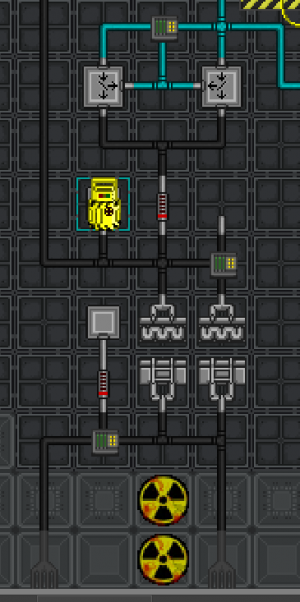
The pipes along the left wall of the engine room cool and store the unwanted byproducts filtered from the engine hot loop. The black pipes to the right are the intercooler loop; they run out into space and the gas within them is cooled by radiating heat out into space. The byproducts never enter the intercooler loop; it must be filled with coolant (usually phoron, but any gas will do fine.) to work.
The weird grey things between the two pipe networks are the heat exchangers; they let the heated gas in the byproduct lines be cooled by the colder gas in the intercooler loop.
Engine Monitoring
Orange - Power Monitering
Yellow - Engineering Cameras
Green - RCON Console
Purple - Station Alert Console
Pink - Buttons, Clockwise from top left: Reactor Blast Doors, Engine Emitter, Monitoring Room Blast Doors
The Engine Monitoring room, located immediately north of the engine itself, contains five computers as well as three buttons to control the functioning of the engine.
From left to right, the computers are:
- Engine Cooling Control: Shows the status of the engine, including temperature, pressure, and the composition of the gas mixture in the core. It also allows full control over the core vent pump and gas injector, should the hot loop circulation need to be modified.
- Power Monitoring: Allows viewing of the powernet sensors on the current level, which includes the engine output, engine room, engineering, and master grids.
- Engineering Cameras: Provides access to the cameras in the engineering department, which includes the engine room, atmospherics, solar array, and those of any engineering robots or maintenance drones.
- RCON: Monitors and controls all of the SMES on the facility.
- Station Alert Computer: Shows power, atmospheric, and fire alarms from anywhere across the facility.
The three buttons are:
- Reactor Blast Doors (top left): Opens and closes the engine core blast doors.
- Engine Emitter (top right): Toggles the emitter in the engine room on and off.
- Engine Monitoring Room Blast Doors (bottom): Opens and closes the safety shutters separating Engine Monitoring from the engine room.
Procedures
This section describes all of the basic procedures which can be carried out with the engine room equipment, including several procedures which form part of the setup process, but is not a comprehensive guide to engine setup. For that, see Engine Setup below.
Injecting Coolant
The line of canister ports just north of the Thermoelectric Generators allow gas to be freely added and removed from both the hot and cold loops. To add coolant to the engine:
- There are four phoron canisters in engineering gas storage room behind the blast doors to the south. Pull two to the input ports in the center.
- Use a
 wrench on the canisters to attach them to the ports.
wrench on the canisters to attach them to the ports. - Turn on the pumps Pump.png leading from the port and maximize their output. (You can replace them with high power pump if you want them to drain faster though only the cold loop will benefit from this change)
- When the coolant canister is empty,
 wrench it again to disconnect it, and either reuse it as a drain tank or drag it to Atmospherics so that it can be refilled.
wrench it again to disconnect it, and either reuse it as a drain tank or drag it to Atmospherics so that it can be refilled. - Repeat this again with another two tanks, so there are two canisters of phoron in each loop.
Starting the Engine
Do not start the engine unless all other engine setup has been completed.
Starting the engine entails activating the supermatter core using the emitter in the engine room. In can be done from either inside the engine room itself, or inside the Engine Monitoring Room.
- Ensure that all engine setup has been completed.
- Open the Reactor Blast Doors using the appropriate button.
- Activate the
 emitter.
emitter.
- From inside the engine room, click on the emitter itself with an empty hand. From the Engine Monitoring room, press the button.
- Allow the emitter to fire the required number of shots.
- The emitter fires in bursts of four shots with a longer pause between bursts. You can turn it off at any time, even in the middle of a burst.
- 16 shots will provide sufficient power to the facilty for the the length of a normal shift. Additional shots will provide more power, but risk causing radiation to penetrate beyond the engine room into the monitoring room and engine hallway.
- Laptops and tablets can download the supermatter monitor program, EER is the reactivity of the engine and temp is safe all the way up to 5000 k, you can use this to judge how many shots the engine really needs and if it has gone cold during the long shift.
- On Cryogaia Outpost, the cooling system is efficient enough that you can leave the emitter on the whole round as long as you pipe the waste to atmos (shown below). However, safety-minded or just plain paranoid engineers may not want to do so as a safety measure.
- Turn the emitter off in the same way you turned it on.
- Close the Reactor Blast Doors.
Removing Engine Coolant
In some situations, such as minor overheating of the engine, you may wish to purge the engine of coolant before injecting more. The engine is specifically designed to allow you to pump coolant into canisters in order to do this.
- Find an empty canister and relabel it as a hazard canister.
- (To do this, click on the canister with an empty hand to access its control panel, and then click the "Relabel" button. The button will be greyed out unless the canister is completely empty)
- Use a
 wrench to attach the hazard canister to hot loop gas removal connector, on the far left of the engine room.
wrench to attach the hazard canister to hot loop gas removal connector, on the far left of the engine room. - Turn the pump on and set the target pressure to maximum.
- Wait for the engine to drain. This can take time, and may require changing a full hazard canister for an empty one, using a
 to disconnect the one and connect the other.
to disconnect the one and connect the other.
- In an emergency, it is seldom necessary to fully drain the engine before injecting new coolant. Alternating between both may be less risky.
- Once the engine has drained, turn off the pump.
- Disconnect the hazard canister containing the drained coolant, and return it to Atmospherics to be emptied.
- It is essential to add new coolant if the old coolant has been drained. Without coolant, the engine will rapidly overheat.
Venting the Core
When engine overheating is serious enough that there is no time to drain the engine, the coolant inside the engine can instead be vented into space. There is a shutter south of the core which vents directly into the atmosphere. There are two buttons which control this shutter. One is located on the southwest wall of the engine room, another in the Chief Engineer's Office on the north wall.
Venting the core is as simple as pressing either of the two buttons to open the shutters, and allowing the coolant to vent. This can take a long time - up to a minute or two if the coolant is especially hot or high-pressure - since much of the coolant will be in the pipes rather than in the core when venting starts. Engine pressure can be monitored from the Engine Cooling Control computer in Engine Monitoring or a laptop/tablet with Supermatter monitoring program installed.
The planet's air will cool a critical engine, so the vent should be left open while you prepare to refill the chamber, and closed once the coolant is ready to inject Only close the vent when the coolant is ready and the waste loop is empty or connected to Atmos, as the engine will be flooded with oxygen and start to delaminate until the coolant replaces the oxygen.
Once the core has been fully vented, be sure to close the shutter before refilling it with coolant.
Ejecting the Supermatter
As of writing it is physically impossible to eject the supermatter in a timely fashion as the blast doors on the outter wall are depowered, if it is too late to vent the engine, which will stop most delaminations, then please inform the crew to prepare for hallucinations and radiation, if you aren't in a radiation protected suit the exposure may be lethal.
Engine Setup
This section details the process of setting up the engine for the first time at the start of the shift.
Many people have developed additions to this procedure which they carry out as standard, but unless you're told otherwise the steps which are listed here are more or less universal.
Coolant Setup
Setting up the engine cooling system is essential to prevent the engine from overheating.
- Configure the filters in the hot loop. Set both of them to filter Phoron, so only that gas goes back into the loop. Once they are set, turn them on.
- There are four phoron canisters
 in engine gas storage west of the engine core.
in engine gas storage west of the engine core. - Place a can directly over the hot loop input and cold loop input connectors
 and wrench them to secure them.
and wrench them to secure them. - Turn on the pumps
 leading from the port and maximize their output.
leading from the port and maximize their output. - Wait until the cans are fully drained (the pump will show that its power use is 0).
- Once those are empty, remove those and place a second pair of cans on the inputs to drain. There should be two canisters worth of gas in each loop.
- Unwrench the canisters, and add an additional phoron canister to the cold loop connector.
- Turn on the high-power pump
 near the window west of the connector ports to circulate the cold loop.
near the window west of the connector ports to circulate the cold loop. - Make sure to maximize the coolants pumps output, or risk damage by overheating.
Engine Waste and Intercooler Loop
In most cases, it is highly beneficial to send the waste loop to atmospherics in the floor below, so it can be better filtered and re-processed.
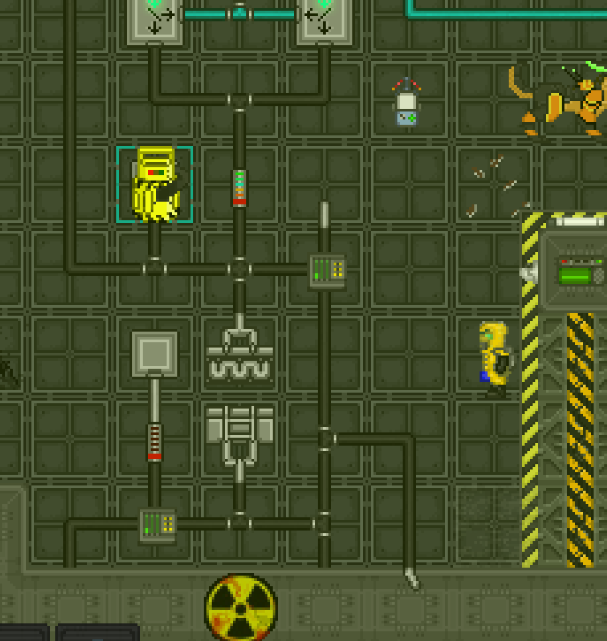
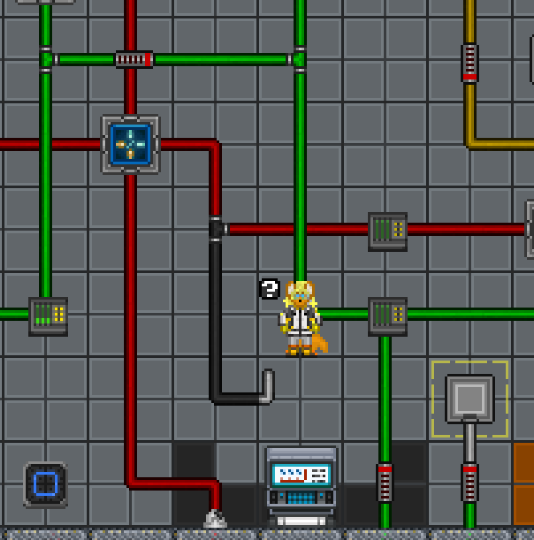
- First, grab a
 wrench and a
wrench and a  Rapid Pipe Dispenser, which can usually be found in Atmos.
Rapid Pipe Dispenser, which can usually be found in Atmos. - Unwrench the right-most heat exchangers and replace them with a pipe and a manfold.
- Run the new pipeline as shown in the image, and place a down-pipe on the wall shown in the image.
- Now go downstairs to the southwest corner of atmospherics.
- Create an up pipe facing west, manifold to replace the red pipe as shown, and a pipeline connecting the new black line coming from the engine to the Atmos' filtering loop.
With this setup, the engine's waste is now being efficiently re-processed and stored in atmos.
Activating the Supermatter
Now that everything is set up, you can start the engine.
- Be sure to wear optical meson scanners
 and a complete radiation suit
and a complete radiation suit 
 if performing this from the engine room, as it involves visual contact with the supermatter crystal.
if performing this from the engine room, as it involves visual contact with the supermatter crystal. - Click the 'Engine Monitoring Room Blast Doors' button on the southeast corner of the core chamber to close the shutters between the engine room and Engine Monitoring.
- This step can be performed from the monitoring room, the button is on the bottom center of the table.
- Click the 'Reactor Blast Doors' button just below the first button to open the supermatter chamber blast doors.
- This step can be performed from the monitoring room, the button is on the upper left of the table.
- Click on the emitter
 and let it fire. Unless you performed the steps to pipe waste to Atmos it is recommended you turn off the emitter at 1400 EER(You can see the monitor on a laptop or tablet), the shifts on this station are long and eventually the canister will fill and clog the engine, it is recommended to set up RCON so that the station will remain powered as the SM cools.
and let it fire. Unless you performed the steps to pipe waste to Atmos it is recommended you turn off the emitter at 1400 EER(You can see the monitor on a laptop or tablet), the shifts on this station are long and eventually the canister will fill and clog the engine, it is recommended to set up RCON so that the station will remain powered as the SM cools.
- This step can be performed from the monitoring room. Use the engineering camera monitor to visually ensure that the reactor blast doors are open before firing. The button is on the upper right of the table.
Setting Up the SMES
A lot of this section's content is taken and adapted from Holdeltas guide to the Supermatter. While the guide on this wiki has more up-to-date information, credit for the information on the linked guide goes to Holdelta.
RCON is the name for the SMES Remote control system on the station. With it, you can remotely set the input and output values for every subsystem in the building - meaning, you could increase for example, the Science department's power allotment as they used the most from time to time.
Power flows in a specific way on the station. It looks a bit like this: TEGs -> Engine SMES And Main SMES -> APCs connected to the main grid -> SMES across the entire station (once RCON is set up otherwise they bypass this) -> APCs connected to those SMES.
Knowing this, we can configure our SMES-es for maximum power efficiency across the station. This part of the guide covers a good set-up for the default engine configuration, so it may require adjustment if you made any changes to the power setup, like upgrading the main smes with coils found in secure storage.
- Get to the RCON console, either in the engine control room, or in the Monitoring room, or from anywhere via your laptop.
- Set the power inputs and outputs for the Main SMES to high values. This is going to be the maximum power transfer to the whole station and determines how quickly it will charge.
- Divide this power to all the other departments. The sum of the power assignment of all the other subgrids should not exceed the total output of the Main SMES, but power will still attempt to spread evenly prioritizing APCs so going a little over is ok
- A good output value for all departmental SMES is 100 kw, increase as needed for science, mining, security, TComms and medical.
- Turn off all the bypass breakers, so the subgrids don't all feed directly from main power and instead must use their assigned power allotments.
Optimization and Maintenance
Buy or bring a laptop, a lot of engineering tasks can be done by using a laptop computer, with it you can manage RCON from anywhere, remotely control air alarms and troubleshoot Atmos issues, monitor engineering cameras, view the alarms and power flow of the entire station, but most importantly this one device serves as an early warning system for the Supermatter, using the SM monitor program you can see EER (reactivity), temperature, what gases are in the engine and the total chamber pressure, the Supermatter will only delaminate if exposed to a vacuum or a temperature of 5000 k.
AR-E glasses are your friend and can be dispensed from the engine vendor in front of the CE office, with them you can see the station alarms at all times, they will be your first alert to all issues, if the engine room has a power alarm you can fix it well before the supermatter tells you there's a problem, and as an added bonus you can weld with them like welding goggles without losing your sight. They will not protect you from the Supermatter however, so always wear Mesons in the engine room if the blast doors are open.
Engine Emergencies
If the core chamber gets too hot, the supermatter crystal will begin to lose stability and delaminate. In such situations, the Engine Monitoring Computer will make an announcement over the engineering radio channel to that effect. If you hear this announcement, hotfoot it to the engine room immediately. Unless there are many other engineers on shift to do it, your first priority is to get the engine under control.
The first thing you should do is try to find the problem which caused the engine temperature to spike. Power failures due to not setting the ![]() engine SMES output high enough, or not turning its input from "Off" to "Auto", are surprisingly common. A loss of coolant through filter failure or external chamber breach are also possible sources of overheating. Otherwise, any number of things may be tampered with by a troublemaker to cause things to go awry. Often, simply finding and fixing the problem will cause the engine to stabilise by itself. If, however, the core integrity drops below 50% and you have not found the cause, you urgently need to cool the core if only to give yourself time to find the root of the problem.
engine SMES output high enough, or not turning its input from "Off" to "Auto", are surprisingly common. A loss of coolant through filter failure or external chamber breach are also possible sources of overheating. Otherwise, any number of things may be tampered with by a troublemaker to cause things to go awry. Often, simply finding and fixing the problem will cause the engine to stabilise by itself. If, however, the core integrity drops below 50% and you have not found the cause, you urgently need to cool the core if only to give yourself time to find the root of the problem.
There are essentially three things you can do to get the engine temperature down to safe levels while searching for and fixing the source of the problem:
Emergency Cooling Valves are placed below and to the above the TEGs. Opening both valves combines the hot and cold loops, directly connecting the core chamber input and output vents to the main radiator array. This drastically increases the rate that heat can be removed from the chamber assuming there is any amount of coolant available. Doing this is a solid first move if stability is still dropping and the source of the problem is not readily apparent. Note that while the loops are merged minimal power will be produced from the TEGs, so this is not ideal if the cause of overheating is lack of power to the engine room.
Emergency Coolant Injection is always a stopgap measure, but it can be one that saves your life. Injecting fresh coolant into the engine without getting rid of the current coolant is a quick way to bring the overall chamber temperature back down while you work to resolve the source of the overheating. This is especially effective if Atmospherics have cooled some Phoron especially for use as emergency coolant.
Venting and Replacing the coolant is a faster, though more wasteful, method of accomplishing the same thing. If core stability drops below 40% and you aren't well on your way to resolving the primary issue opening the vent will expose the engine to cold oxygen, effectively putting it on ice, from there you can troubleshoot the issues and replace the coolant, note the engine will be flooded with oxygen so have your replacement coolant ready to be wrenched down immediately upon closing the vent, temperatures will rise quickly at first, but by the second canister of coolant it will stabilize, only close the vent once you have identified the issue otherwise you will be right back where you started.
Ejecting the Supermatter is the final option and should not be performed unless under the most dire circumstances beyond the scope of this guide. If stability drops below 20% and it seems that you cannot stop the loss of stability even with the vent open, you should eject the core as per Procedures above (You will need to manually open the outer wall or have it already open). If there are enough engineers on staff, at least one should be standing by to eject while the others work on other methods of getting the core under control and figuring out what is wrong, if venting isn't working check the apc, the engine room might be depowered making ejecting impossible.
| Guide Table | ||||||||
| Starter | Medical | Engineering | Science | Security | Other | Development | ||
